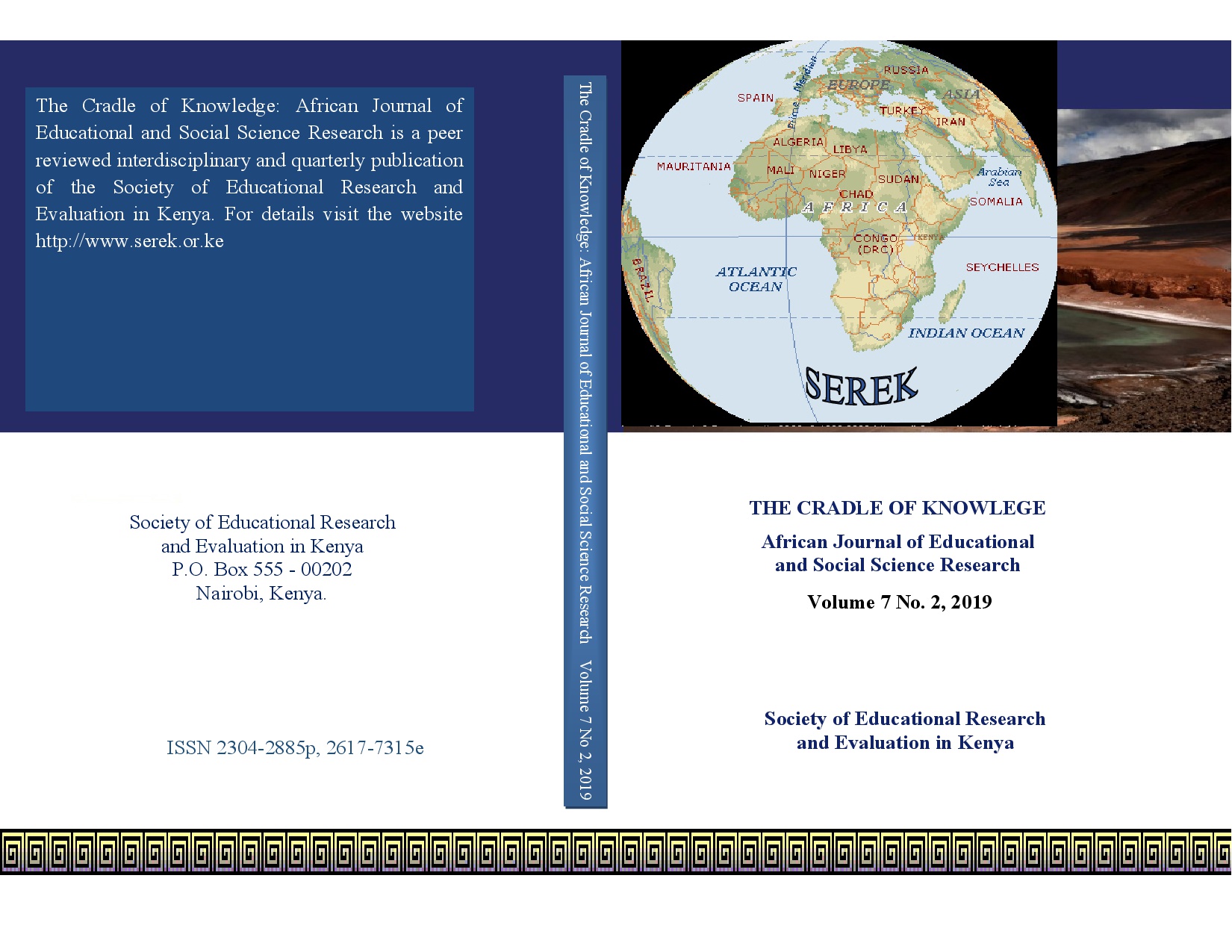
School Leadership: Role of Age and Gender in the Principal’s Religiosity
Abstract
This study explored the principals’ age and gender as factors in his religiosity and leadership. Concerns have been raised on the leadership of secondary schools in Nandi County. Lack of good leadership in sub county, county and even extra county schools has lead loss of property in these schools and if this is allowed to continue, some schools may be forced to close down. Would a principal’s religiosity help? Is religiosity affected by age and gender? Ex- post facto research design guided the research whose target population was principals, teachers and student leaders of secondary schools in Nandi County. Stratified and simple random sampling was used to sample schools, teachers and student leaders. The study used three data collection methods; questionnaire, interview schedule, and content analysis guide. Experts were consulted to determine the content validity of instruments. Reliability was determined by use of Cronbach’s alpha technique giving a value of 0.715 and Hypotheses 1&2 on age and gender were tested using t-test and analysis of variance. To determine relationship between religiosity and both age and gender, t- tests was carried out. The findings showed that one’s religiosity did no change with age, but it depended on gender. Female principals would be preferred in relation to integrity concerns. Principals should meet a minimum requirement in terms of education, experience and level of religiosity to be allowed to run schools. The findings of the study may be applied in drafting a better policy on principals’ appointment.
Key words: Principal, Religiosity, Age, Gender, School Leadership.
Full Text:
PDFReferences
Albaum, G (2006). Ethical attitudes of future Business leaders: do they vary by gender and Religiosity? University of New Mexico Sage Publications.
Barber, N. (2011) A Cross-National Test of the Uncertainty Hypothesis of Religious Belief. Cross-Cultural Research, 46, 316- 331.
Google Scholar, Link, ISI.
Basic Education Act, (2013). Special Report by P. Mutuku, www. Kenyalaw.org>lex.
Bergan, A (2000). Religiosity and life satisfaction. Activities adaptation and aging 24(3), 23-34. New York: Guilford Press
Coleman, M. (2012). Gender and educational leadership. A comparison of secondary headteachers views over time 27(4) 383-399.
Covey, S. (2001). Leadership is a choice: The four roles of a Leader. http://www.wyn.com. Retreated 29th Dec. 2016.
Hardy, S., (2005). Religiosity and prosocial behaviours in adolescence: the mediating role of prosocial values. Journal of Moral education. 34 (2), 231-249.
Ken, Z. (2005). Teacher education programs cochran- smith (ed). NJ: LawreneErlbaun
Kenya National Bureau of Statistics (2015) Economic Survey 2015,
Kucukcan, T. (2010). Multidimensional approach to religion: a way of looking at religious phenomena. Journal for the study of religions and ideologies. Vol4(10), 60-70.
Lewis et al (2011) Management of Human Service Programs. Retreaved s14th dec. 2016. https://books.com>general.
Ministry of Education (2005). Kenya Education sector support programme (KESSP) 2005 -2010. Nairobi: Government press.
Ministry of Education (2016) Implementation of Free Secondary Education and Challenges. 2016-22. Nairobi: Government Press.
Nicholas, A (2013) intersecting Gender with Religiosity Stage publications
Republic of Kenya (2005). Sessional paper no 1 of 2005, a policy framework for Education, training and research. Nairobi: Government printer Retreaved 18thdec. 2016.
Sang and Otunga (2006). The Educator: Journal of the School of Education. Eldoret: Moi University Press.
Stronge, J. (1993). Defining the principalship. Instructional Leadership or Middle Manager. National Association for Secondary Schools Principals Bulletin, 77, 1-7.
Trorey, G. and Cullingford, C. (2002) Professional Development and Institutional needs. Hampshire: Ashgate Publishing Limited.
World Bank (2016). Global Economic Prospects: World Free of Poverty. www.endpoverty.org.
Refbacks
- There are currently no refbacks.
SEREK publication https://serek.or.ke
This work is licensed under a Creative Commons Attribution 4.0 International License